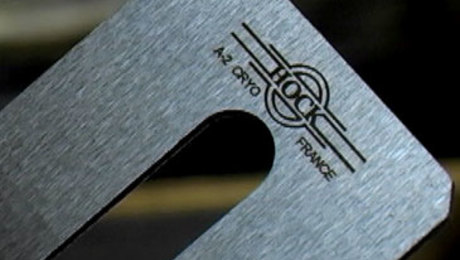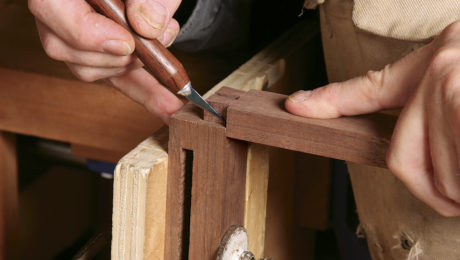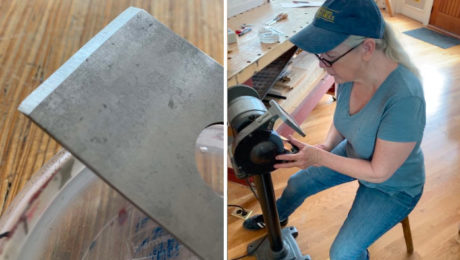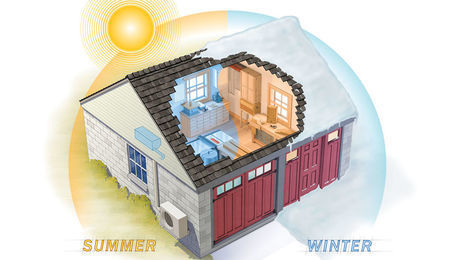STL271: Making Dull > Getting Sharp
Megan Fitzpatrick joins Vic and Ben to discuss replacement plane blades, grinding angles, rabbeting dovetails and our first ever (we think) live call in!Question 1:
From Luke:
Two quick questions. Every vintage plane discussion on this show typically includes a recommendation to “throw a hock iron in there and get to work.” So, what is a hock iron and why do I need one vs another manufacturer?
 |
Hock Factory TourIn this exclusive video, Ron Hock shows you where his legendary plane blades are made |
Question 2:
From Darren:
Hello Shop Talk
I have been woodworking for many years and I have somehow got away without cutting any dovetails. I would like to fix that and gave myself a goal this year to learn how to cut them.
I notice in some videos the person uses a small rabbet to align the tail board over the pin board during the transfer. In many of the videos I see they use a rabbet block plane. I have a couple questions;
Do you suggest this method of paring to align the tail board? Is to align the only reason?
If so; I have a Record No. 778 Fillester Plane, a Record 311 shoulder plane and a chisel. Is there a preferred method for cutting this rabbet and what depth?
 |
Shoulder Your DovetailsMake layout easier and get cleaner results |
All-time favorite tools of all time… for this week
Ben – Starrett English/Metric 300mm ruler
Vic – The most adorable oil can ever
Megan – UV flashlight for finding cat pee errant glue on a project
Question 3:
From Damon:
I use mostly bevel up planes, and hone the irons to different bevel angles depending upon the purpose. I picked up a slow speed grinder and Veritas tool rest to help more quickly establish the primary bevels. Is there any reason not to just stick with a 25 degree primary bevel for everything, even if I’m going to hone at 40 degrees? I’m wondering if there’s any benefit to the extra meat behind the cutting edge with a steeper grind. It would seem that Veritas thinks so since they offer blades with a 38 degree primary bevel.
 |
Grind and get back to work – fastFor Megan Fitzpatrick, there is simply no faster way to remove a chip from a blade or erase a too-large secondary bevel than a high-speed wheel grinder. |
Call in question:
From Antonio:
I have a question I don’t think has been answered on the show previously. I live in Buffalo, NY and weather is a factor in my question about the need for a new shop.
My wife and I are soon to move into a new house and I’m a little torn on what I want to do for my shop space. I’m a hobby woodworker, with a fairly good setup right now in a detached single car garage that is too small to house either of our cars, thereby giving me the latitude to put my workshop out there. I have a standard handful of larger tools: tablesaw, planer, small bandsaw, sander, lathe, dust collector. With the addition of a couple of rolling tool boxes for hand tools, planes, chisels etc. Ideally I’d like to add a couple other larger tools like a jointer and upgraded bandsaw/saw stop in the future.
The new house has an attached garage, with no out building large enough to hold my tools and for the intended furniture making. My dilemma is: do I setup my small attached garage, with easy access to wiring (adding 220v), as well as the abilty/ease of adding some sort of heating when the budget will allow, and keep everything on wheels? Since we would like to use the garage for car storage in the winter, by pushing all the tools against the walls when needed. And also making it easier, as well as increasing my willingness to go out to the garage on the 5 or so months of below optimal shop temperatures. Additionally I could likely get into this setup quickly, and without much effort from my current setup. The main downside is that it is directly below what will be our sons bedroom. Keep in mind my woodworking will be mostly nights and weekends, escaping on what feels like borrowed time!
OR, do I put my short term efforts into building a substantially sized shed/outbuilding to be my primary shop location. Luckily I have the yard space, and the budget could likely be agreed upon by the better half. But this would be a full ground-up build, electrical, foundation, literally everything. But this would be completely dedicated space, exactly to my specs. The downside would be that heating, or getting it to a comfortable temp, during the aforementioned winter months. And for short periods of shop time may be difficult to heat, thereby decreasing my likelihood of actually going out there when it’s cold.
 |
Heating and Cooling Your ShopDuctless HVAC systems ensure that the weather doesn’t limit your shop time |
Every two weeks, a team of Fine Woodworking staffers answers questions from readers on Shop Talk Live, Fine Woodworking‘s biweekly podcast. Send your woodworking questions to shoptalk@taunton.com for consideration in the regular broadcast! Our continued existence relies upon listener support. So if you enjoy the show, be sure to leave us a five-star rating and maybe even a nice comment on our iTunes page.





















Comments
Please don’t go bashing on sharpening fanatics. Getting under 50 grams on our Edge on Up on a chisel may be the most fun we have all day.
To be clear on where I stand on sharpening, I own a large box of sharpening stones and guides, I have an Edge On Up, and I have no hair on either forearm.
After doing the garage floor shuffle for most of my life, when I retired I wanted to have a stand alone shop. At my new house I had a 14 x 24 Tough Shed built. The windows are dual paned. Over the last few years as economics allowed I've been making it into a comfortable shop. 1st I had an electrician wire it. I had plenty of outlets and lighting installed. Double ganged outlets about every 8 feet around the walls. I had 1 220 outlet installed. Wish I'd had 2. Then I installed insullation. A few months later I put up plywood ceilings and walls. Last winter I had a gas heater installed. Where I live in Utah air conditioning isn't really necessary. There are only 2 problems. The floor is going to have to be beefed up. Tough Shed didn't realize the weight of machines. I'll get to that shortly. Since it sits on piers on the ground I've had to level the floors. It's a matter of jacking it up and shimming at the piers. Other than that it is working well.
About a year ago we moved and I found myself in the same situation as your guest last week: basement shop vs. garage shop vs. stand-alone shop. I decided on a 24'x 24' stand-alone woodshop and I am ecstatic about it after decades in basements. I can make dust early in the morning or late at night and wake no one! No carrying wood to the basement! I just finished installing knotty pine walls and the only decision I still need to make is what to do about climate control. We live just north of Milwaukee WI. It can be very cold here but we average only nine days per year above 90 degrees. I could do without AC and love the idea of a wood burning stove for heat. BUT, I am concerned about rust and wood movement. I have 6" insulated walls, insulated garage doors, and a vapor barrier on all surfaces, including below the insulated concrete floor.
I am now searching for answers to the following questions. Do I need AC? Can I control condensation with a dehumidifier? Should I be concerned about how fast a wood stove heats the air leading to condensation? And finally, what should I be concerned about that I am not thinking about now? Thanks for any advice you may have for me.
Dave
Cosman is now teaching to just use a few pieces of tape in place of the rebate. As Megan said, all you need is a positive registration to help with aligning the boards. BTW this is the step that is overshadowed by most who teach dovetails. It is the second most difficult step after getting the tail cut perfectly 90 degrees.
+1 for the stand alone shop. For dozens of reasons… if it fits the budget. I daresay I’d go down market stand-alone and upgrade as it can be afforded later. I was in a 16x20 drop off shed for a while. Beat the daylights out of using the basement. And my power was a portable generator in that space. Management appreciated lower noise levels n lower dust levels. Just my 2 cents
Take the pain now, Antonio. Going the other route will disappoint eventually and you'll wish you'd gone the more difficult way to give the maximum potential. We all evolve in our woodwork. Don't cramp your future.
I live in upstate NY but out in the country - of which there is a lot around here (bear print on shop door two years ago). I was in the basement but had issues with humidity and tool rust, wonderful wife suggested standalone shop. I contracted for a 26 x 30 with 10' ceilings and a half floor above. 2 x 6 walls and ceiling with R19 in both - very important. I had 50 amp line run to a sub panel, did the rest of the wiring myself, both 220 and 11o in multiple outlets around the shop. Insulated, drywall, lights, trim myself. NO GARAGE DOOR! All they do is leak heat both in or out, regular insulated double door. I have a insulated trap door with spring assist to get to the top storage area. Heating is a mobile home furnace using propane. NO AC at all.
The R19 keeps it cool enough not to need AC around here, 90 outside today, 71 inside this evening. I cannot vent the shop in summer because when the warm humid outside air hits my iron TS surface, I get condensation and rust. I do have a small compact dehumidifier but cannot run it because it will heat up the shop if on for 2-3 days in a row. See R19 above.
Lights were 48" T8's, replaced with direct wire LED's. No ballasts very efficient.
To net out the above if you build a stand alone shop: Design for thermal efficiency, insulated windows, doors (not overhead), insulate ceiling. Space outlets for power accordingly. Heat source will depend on square feet. I heat with propane when I am out there, burn about 120 gal/year.
Good Luck!!
Log in or create an account to post a comment.
Sign up Log in